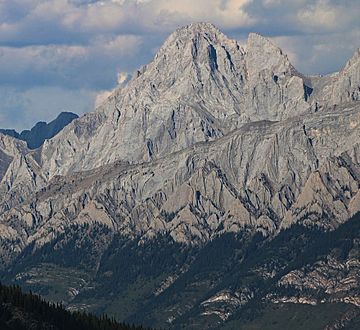Mount Blane (Alberta) facts for kids
Quick facts for kids Mount Blane |
|
|---|---|

Mount Blane, west face shown
|
|
| Highest point | |
| Elevation | 2,993 m (9,820 ft) |
| Prominence | 204 m (669 ft) |
| Parent peak | Mount Jerram (2996 m) |
| Listing | Mountains of Alberta |
| Geography | |
| Location | Alberta, Canada |
| Parent range | Opal Range Canadian Rockies |
| Topo map | NTS 82J/11 |
| Geology | |
| Age of rock | Cambrian |
| Type of rock | Limestone |
| Climbing | |
| First ascent | 1955 by P.J.B. Duffy, G. Hohnson, D. Kennedy, F. Koch |
Mount Blane is a tall mountain peak in the Canadian Rockies. It stands in Alberta, Canada, and is part of the Opal Range. This mountain is about 2,993 meters (9,820 feet) high. Its closest taller neighbor is Mount Jerram, which is a short distance to the southeast.
Contents
The Story of Mount Blane
How Mount Blane Got Its Name
Mount Blane was named to honor a brave man named Sir Charles Rodney Blane. He was a commander in the British Royal Navy. He commanded a large warship called HMS Queen Mary.
Sadly, he was killed in a big sea battle called the Battle of Jutland in 1916. His ship exploded and sank during this battle. The mountain was officially named in his honor in 1922. This decision was made by the Geographical Names Board of Canada.
First Climbers to Reach the Top
The very first time people climbed to the top of Mount Blane was in 1955. Four climbers made this first ascent. Their names were P.J.B. Duffy, G. Hohnson, D. Kennedy, and F. Koch.
Sadly, one of the climbers, F. Koch, passed away during the climb down from the mountain.
How Mount Blane Was Formed
The Rocks of Mount Blane
Mount Blane is made of a type of rock called sedimentary rock. This rock formed over millions of years from tiny bits of sand, mud, and shells. These layers of sediment were laid down in shallow seas a very long time ago.
The rocks of Mount Blane were formed during periods known as the Precambrian to Jurassic times. These are very old geological periods.
How Mountains Are Built
Later, these flat layers of rock were pushed up and folded. This happened during a major mountain-building event called the Laramide orogeny. During this time, huge forces pushed the rock layers eastward. They even slid over younger rocks, creating the tall mountains we see today.
Weather and Climate
Mount Blane's Climate Zone
Mount Blane is located in a subarctic climate zone. This means it has very cold and snowy winters. The summers are usually mild, not too hot.
Temperatures on the mountain can often drop below -20 degrees Celsius (-4 degrees Fahrenheit). With the wind blowing, it can feel even colder, sometimes below -30 degrees Celsius (-22 degrees Fahrenheit).
Best Time to Visit
If you want to climb Mount Blane, the best time to go is usually from June through September. During these months, the weather is more favorable for outdoor activities.
Water Flow from the Mountain
Water from melting snow and rain flows off the mountain in different directions. On the west side, the water drains into the Kananaskis River. On the east side, the water flows into smaller streams that eventually join the Elbow River.



